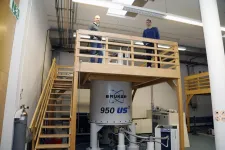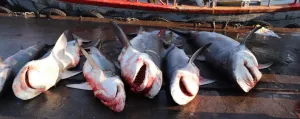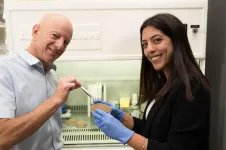Researchers at Goethe University Frankfurt and TU Darmstadt began networking internationally from the very start of the pandemic. Their goal: to describe the three-dimensional structures of SARS-CoV-2 molecules using nuclear magnetic resonance spectroscopy (NMR). In NMR spectroscopy, molecules are first labelled with special types of atoms (isotopes) and then exposed to a strong magnetic field. NMR can then be used to look in detail and with high throughput at how potentially active compounds bind to viral proteins. This is done at the Centre for Biomolecular Magnetic Resonance (BMRZ) at Goethe University and other locations. However, the basic prerequisite is to produce large quantities of the proteins in high purity and stability, and with their correct folding, for the large amount of tests.
The network, coordinated by Professor Harald Schwalbe from the Institute of Organic Chemistry and Chemical Biology at Goethe University, spans the globe. The elaboration of laboratory protocols for the production of proteins is already the second milestone. In addition to proteins, the virus consists of RNA, and the consortium already made all important RNA fragments of SARS-CoV-2 accessible last year. With the expertise of 129 colleagues, it has now been possible to produce and purify 23 of the total of almost 30 proteins of SARS-CoV-2 completely or as relevant fragments "in the test tube", and in large amounts.
For this purpose, the genetic information for these proteins was incorporated into small, ring-shaped pieces of DNA (plasmids). These plasmids were then introduced into bacteria for protein production. Some special proteins were also produced in cell-free systems. Whether these proteins were still correctly folded after their isolation and enrichment was confirmed, among other things, by NMR spectroscopy.
Dr Martin Hengesbach from the Institute of Organic Chemistry and Chemical Biology at Goethe University explains: "We have isolated functional units of the SARS-CoV-2 proteins in such a way that their structure, function and interactions can now be characterised by ourselves and others. In doing so, our large consortium provides working protocols that will allow laboratories around the world to work quickly and reproducibly on SARS-CoV-2 proteins and also the mutants to come. Distributing this work from the beginning was one of our most important priorities. In addition to the protocols, we are also making the plasmids freely available."
Dr Andreas Schlundt from the Institute for Molecular Biosciences at Goethe University says: "With our work, we are speeding up the global search for active agents: Scientific laboratories equipped for this work do not have to first spend several months establishing and optimising systems for the production and investigation of SARS-CoV-2 proteins, but can now start their research work within two weeks thanks to our elaborated protocols. Given the numerous mutations of SARS-CoV-2 to come, it is particularly important to have access to reliable, rapid and well-established methods for studying the virus in the laboratory. This will, for example, also facilitate research on the so-called helper proteins of SARS-CoV-2, which have remained under-investigated, but which also play a role in the occurrence of mutations."
INFORMATION:
In the meantime, the work in the NMR consortium continues: Currently, the researchers are working hard to find out whether viral proteins can bind to potential drugs.
The research work was funded by the German Research Foundation and the Goethe Coronavirus Fund. The high logistical effort and constant communication of research results was supported by Signals, a spin-off company of Goethe University.
Partners:
Brazil
- National Center of Nuclear Magnetic Resonance (CNRMN, CENABIO), Federal University of Rio de Janeiro, Brazil
- Institute of Medical Biochemistry, Federal University of Rio de Janeiro, Brazil
- Multidisciplinary Center for Research in Biology (NUMPEX), Campus Duque de Caxias, Federal University of Rio de Janeiro, Duque de Caxias, Brazil
- Institute of Chemistry, Federal University of Rio de Janeiro, Brazil
- Multiuser Center for Biomolecular Innovation (CMIB), Department of Physics, São Paulo State University (UNESP), São José do Rio Preto, Brazil
- Laboratory of Toxicology, Oswaldo Cruz Foundation (FIOCRUZ), Rio de Janeiro, Brazil
France
- Molecular Microbiology and Structural Biochemistry (MMSB), UMR 5086, CNRS/Lyon University, France
- Université Grenoble Alpes, CNRS, CEA, IBS, Grenoble, France
Germany
- Institute for Organic Chemistry and Chemical Biology, Goethe University Frankfurt, Germany
- Center of Biomolecular Magnetic Resonance (BMRZ), Goethe University Frankfurt, Germany
- Institute for Molecular Biosciences, Goethe University Frankfurt, Germany
- Institute for Biochemistry, Goethe University Frankfurt, Germany
- Institute of Pharmaceutical Chemistry, Goethe University Frankfurt, Germany
- Institute of Biophysical Chemistry, Goethe University Frankfurt, Germany
- BMWZ and Institute of Organic Chemistry, Leibniz University Hannover, Germany
- Group of NMR-based Structural Chemistry, Helmholtz Centre for Infection Research, Braunschweig, Germany
- Structural Genomics Consortium, Buchmann Institute for Molecular Life Sciences (BMLS), Germany
- Signals GmbH & Co. KG, Frankfurt am Main, Germany
- Leibniz Institute on Aging - Fritz Lipmann Institute (FLI), Jena, Germany
- IBG-4, Karlsruhe Institute of Technology, Karlsruhe, Germany
- Department of Biology, Technical University of Darmstadt, Darmstadt, Germany
- Institute of Biochemistry and Biotechnology, Charles Tanford Protein Centre, Martin Luther University Halle-Wittenberg, Halle/Saale, Germany.
Greece
- Department of Pharmacy, University of Patras, Greece
Italy
- Structural Biology and Biophysics Unit, Fondazione Ri.MED, Palermo, Italy
- Magnetic Resonance Centre (CERM), University of Florence, Sesto Fiorentino, Italy
- Department of Chemistry "Ugo Schiff", University of Florence, Sesto Fiorentino, Italy
Latvia
- Latvian Biomedical Research and Study Centre, Riga, Latvia
- Latvian Institute of Organic Synthesis, Riga, Latvia
Switzerland
- Swiss Federal Institute of Technology, Laboratory of Physical Chemistry, ETH Zurich, Zurich, Switzerland
Spain
- "Rocasolano" Institute for Physical Chemistry (IQFR), Spanish National Research Council (CSIC), Serrano, Spain
USA
- Institute for Molecular Virology, University of Wisconsin-Madison, WI, United States
- Department of Chemistry, University of California, Irvine, United States
- Laboratory of Chemical Physics, National Institute of Diabetes and Digestive Kidney Diseases, National Institute of Health, United States
- Department of Molecular, Cellular and Biomedical Sciences, University of New Hampshire, Durham, NH, United States
- Department of Molecular Biology and Biochemistry, University of California, Irvine, California, United States
- Department of Molecular Biology and Biophysics, UC 72 onn Health, Farmington, CT, United States



